3D in the mid 60s in Europe with Hi-Fi Stereo 70 |
Read more
at in70mm.com The 70mm Newsletter |
| Written by: Gerhard Witte, Berlin, Germany | Date: 01.07.2010 |
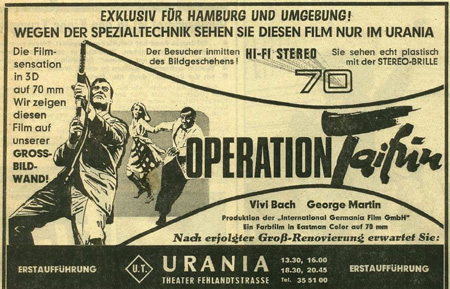 Advertisement from the author's collection Advertisement from the author's collectionIn the mid 1960s the first attempt was made in Europe to use the great advantages of 70mm wide-film for an analogue single-strip 3D projection by fitting the two half-frames of a 3D film next to each other in a 65mm negative film. After conversion work at the U.T. - Urania-Filmtheater, the film “Operation Taifun" (With Death on Your Back) was shown from 21st September 1967 in Hamburg in "Hi-Fi Stereo 70" using the polarisation process. |
More
in 70mm reading: Stereo-70 / Stereokino. Three-Dimensional Cinematography in Russia 3D Mitte der 60er Jahre in Europa mit: “Hi-Fi Stereo 70“ 3D IMAX 70mm today MCS 70 - Superpanorama The Grindel Filmtheater The "Savoy" in Hamburg The Shoes Of The Fisherman |
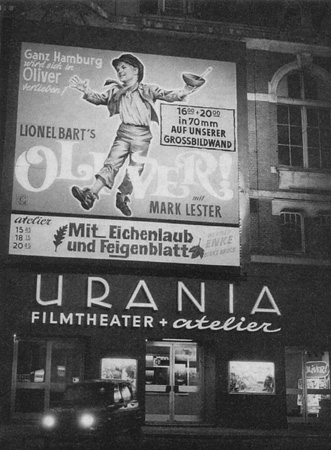 The U.T.-Urania –Filmtheater (Urania Film Stage at Stephansplatz), Hamburg,
Fehlandtstraße 40 as it was at the time. Image and information taken from the brochure: “Filmtheater in der Freien
und Hansestadt Hamburg” 1971/72 season, among other sources. The U.T.-Urania –Filmtheater (Urania Film Stage at Stephansplatz), Hamburg,
Fehlandtstraße 40 as it was at the time. Image and information taken from the brochure: “Filmtheater in der Freien
und Hansestadt Hamburg” 1971/72 season, among other sources. The U.T.-Urania-Filmtheater had been in existence since 1927 and was used, among other things, as an army cinema for the Allies in the post-war period. In 1956 the cinema underwent fundamental modernisation by the architect Helmut Fischer and the CinemaScope projection process was introduced in conjunction with a significantly larger screen. In the summer of 1967, further renovation work was carried out. It got an even bigger screen, 70mm projection machines for wide-film in conjunction with a 4-channel magnetic sound system and new seating (419 seats, with considerably larger distances between rows). Unfortunately, the theatre was completely destroyed by fire in June 1980 and was not subsequently re-built. |
Internet link: Berlin Cinema Compendium Kinomuseum Berlin e.V. The Holographic Studio of the Scientific Research Cinema & Photo Institute Chace Audio The life of Willi Burth The Film- and Televisionmuseum Hamburg List of 3D-Films |
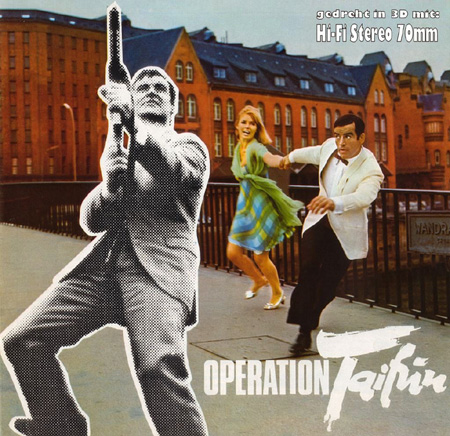 “Operation Taifun” (aka: Spion wider Willen).
Picture from the author's collection. “Operation Taifun” (aka: Spion wider Willen).
Picture from the author's collection.
Con la Morte alle spalle (aka: Con la Muerte en la Espalda)/Electra 1/Putain de mission France/Typhon sur Hamburg/With Death on your Back. FRG 1967. 65mm negative film, presented in 70mm/4 channel magnetic sound. 3D film process: Hi-Fi Stereo 70. A production of the INTERNATIONAL GERMANIA FILM G.M.B.H. In collaboration with P.C.B., Barcelona, C.F.F., Paris and West-Film, Rome. Colour: Eastman Color, 70mm. And other examples of the few films that were made using the process in Europe at the time: |
|
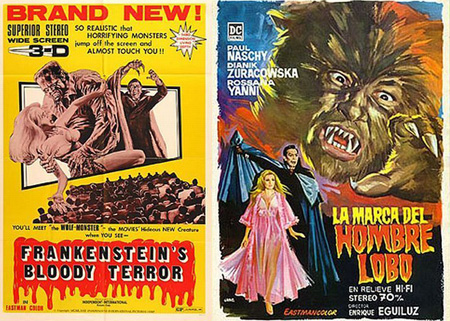 ”Die Vampire des Dr. Dracula”.
Pictures from the author's collection. ”Die Vampire des Dr. Dracula”.
Pictures from the author's collection.Frankenstein's Bloody Terror/Hell's Creatures/Le notti di Satana/ Les vampires du Dr. Dracula/La Marca del Hombre Lobo/The Mark of the Wolfman. Spain 1968. 65mm negative film, presented in 70mm/4 channel magnetic sound. 3D film process: Hi-Fi Stereo 70. |
|
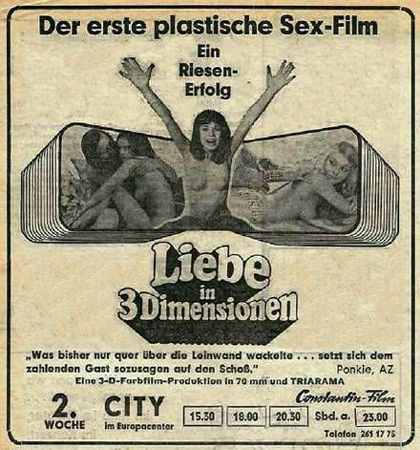 "Liebe in 3 Dimensionen".
Advertisement kindly provided by Jean-Pierre Gutzeit, Kinomuseum-Berlin e.V. "Liebe in 3 Dimensionen".
Advertisement kindly provided by Jean-Pierre Gutzeit, Kinomuseum-Berlin e.V.
Love in 3-D/Amore in tre dimensioni/Amor en 3-dimensiones. FRG 1973. 65 mm negative film, presented in 70mm/4 channel magnetic sound. 3D film process: Hi-Fi Stereo 70 - marketing label of the Constantin film “Triarama“ |
|
 The film
"Operation Taifun" was largely made in 1966/1967 in
Hamburg. That
was also the beginning of a new 3D filming and reproduction process with the
name Hi-Fi Stereo 70 in Europe at the time. The film
"Operation Taifun" was largely made in 1966/1967 in
Hamburg. That
was also the beginning of a new 3D filming and reproduction process with the
name Hi-Fi Stereo 70 in Europe at the time. With this new process it was possible for the first time to reproduce two anamorphic images next to each other, simultaneously with one camera, on a 65mm negative film. As a result of the fact that the camera lenses are eyes' width apart (the standard distance is 63.5mm), a real stereoscopic impression is conveyed when watching the film using the polarisation process. The Stereo 70 camera (which at that time was actually a converted M.C.S. 70 studio camera) was designed by the Norwegian Jan Jacobsen (1916-1998) - also the ingenious designer of anamorphic lenses. Previously he invented the MCS 70 Field Camera, which weighed only 13.5 kg (without cassette). In 1962 it was used to film the first German 70 mm film “Flying Clipper - Traumreise Unter Weißen Segeln" (Mediterranean Holiday). The film was shown again at the Berlin Film Festival Retrospective “70mm- Bigger than Live” on 11 February 2009 using a newly made 70mm copy with DTS sound. |
|
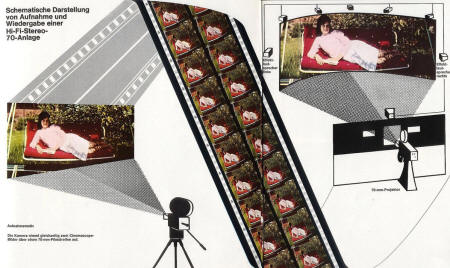 Image taken from the souvenir booklet "Operation Taifun".
The camera simultaneously takes two scope images through a 65mm negative
film – the M.C.S. 70 camera works with 65mm wide film. Image taken from the souvenir booklet "Operation Taifun".
The camera simultaneously takes two scope images through a 65mm negative
film – the M.C.S. 70 camera works with 65mm wide film. Click to see enlargement The two anamorphic base lenses of the Stereo 70 camera have a focal length of 50 mm and a light intensity of f:2.8. The range of focus can be adjusted from 1.50m to infinity (also from 60cm to 2.50m if accessory lenses are used). The convergence point is automatically on the focal plane. However, for special effects the convergence point can be moved in front of or behind the focal plane. |
|
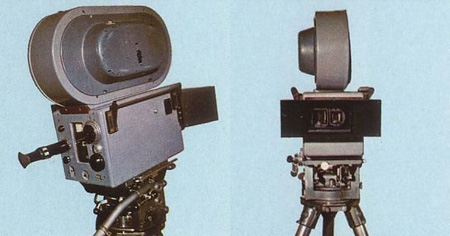 The Camera (converted M.C.S. 70 Studio Camera). Image taken from the souvenir booklet "Operation Taifun" The Camera (converted M.C.S. 70 Studio Camera). Image taken from the souvenir booklet "Operation Taifun"The mechanism of the Stereo 70 camera corresponds to an already proven system. It is a mirror reflex camera with double-sided transport and locking claws, equipped with 300 metre cassettes, combined motor for 16 volt battery drive (4 to 30 frames/sec) and 220 Volt AC (24 frames/sec synchronous). The camera weighs about 45 kg, it makes little noise and can be operated relatively easily (see illustration below). |
|
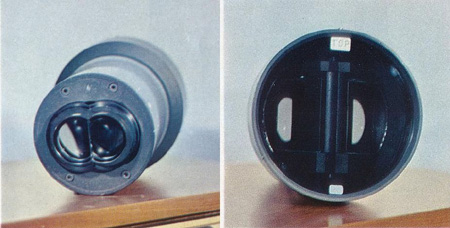 The Projection Lens.
Image taken from the souvenir booklet "Operation Taifun" The Projection Lens.
Image taken from the souvenir booklet "Operation Taifun"For screening in the cinema, a 70mm copy with 4-channel stereo sound is used. The conversion of the theatre is easy to carry out as the film is shown using a special lens (Stereo-Kinotar) on a normal 70mm projector. This special lens was also developed by Jan Jacobsen and consists of two anamorphic units positioned next to each other with two pole filters. The exterior diameter of the special lens corresponds to the international norm, so that conversion of the projector lens carrier is not necessary. The rectified images are almost projected congruently on to the cinema screen. This must be a (metalized) silver screen as traditional projection surfaces would destroy the polarisation of the light (the light reflection properties of a screen are determined by the so-called "gain factor"). With the aid of a pair of polarisation glasses, it is now possible for the viewer to see the correct image with each eye and experience a genuine stereoscopic effect. (information taken from various sources, including the souvenir booklet "Operation Taifun"). |
|
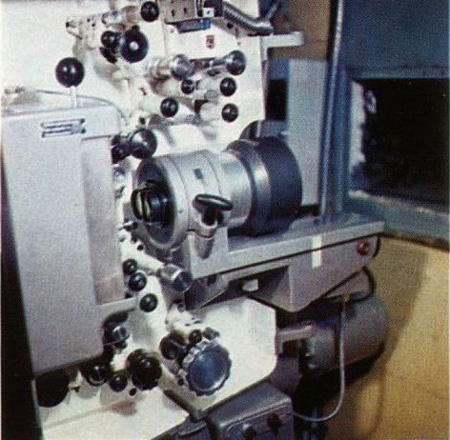 The Projector with Kinotar fitted The Projector with Kinotar fitted As all 3D single-strip projections with a 35 mm film with two stereoscopic image phases lying next to or over each other suffered from a significant loss of light in projection, the 70mm film, which is twice as wide, seemed to be the ideal solution at that time. In other countries work was also being done with similar processes during this period: in America with the StereoVision 70 system and in Russia with Stereo-70, developed by the Russian Scientific Research Cinema & Photo Institute (NIKFI) founded in Moscow in 1929, also in collaboration with Mosfilm Studios (founded in 1920 and so named since 1935). The film negative here is 70mm wide and the photography and reproduction was spherical (no anamorphic lens), side by side. The Stereo-70 films are also projected in 70mm format. For example two of the many films made using this process are entitled: "Net i da" (No and Yes) 1966 and "Tainstvennyy Monakh" (The Mysterious Monk) 1968. The European co-production "Operation Taifun" was not very successful in the cinemas because of its very weak plot. That was no the case with "Love in 3 Dimensions" (in part because of the successful combination of eroticism and 3D). The film enjoyed relatively large success internationally (even in America), also in a 35mm single-strip 3D version. Because of the silver screens required for projection (which are nearly twice as expensive as the usual white screens) and also the slowly declining number of film projection venues for 70mm films, the production of 70mm 3D films was no longer pursued seriously at that time. That only changed later with the introduction of the IMAX (Image Maximation) cinemas. |
|
Looking back |
|
|
As the television set began to be introduced into living
rooms, mainly in America, at the beginning of the 1950s, things started to
look increasingly bleak for cinemas - by 1953 over 47% of families already
owned a set. With the introduction and distribution of 3D films, firstly in
the red-green anaglyph process, then in the significantly better
polarisation process, the attempt was made to fill the cinemas again. The
period from 1952 to 1955 saw a brief boom for these films then. As a result
of many technical problems, e.g. poor quality dual-strip projections
(unsteady images and colour differences which gave people headaches) and the
introduction of so-called "3-dimensional movies with no need for
glasses" with
their curved large screens (CinemaScope/Cinerama/Todd-AO, somewhat later
also in Russia with the Kinopanorama/ Sovscope70 projection process), the
general interest in 3D films slowly disappeared. Moreover, the costs to
cinema owners for the conversion of their cinemas, combined with the
problems associated with the Polaroid glasses (theft, cleaning) were simply
too high in relation to their takings. Apart from a very few exceptions,
there were also no clear 3D film hits. |
|
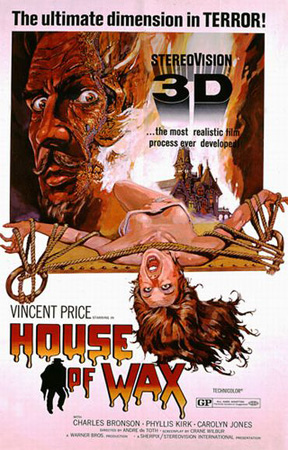 “The first phenomenal merger of 3D action! 3D color! and 3D sound!“
“Das Kabinett des Professor Bondi“.
Picture from the author`s collection. “The first phenomenal merger of 3D action! 3D color! and 3D sound!“
“Das Kabinett des Professor Bondi“.
Picture from the author`s collection.
USA 1953, WarnerColor: House of Wax/The Wax Works/L'homme au masque de cire /Canavarlar sarayi /La maschera di cera/Los crímenes del museo de cera/ Vokskabinettet. 3D filming process: Natural Vision (dual-strip 35mm), start of the 70s also as StereoVision 3D (35mm) and StereoVision 70 (70mm) re-issue. The successful film entitled “Das Kabinett des Professor Bondi (House of Wax)“ filmed in Natural Vision (dual-strip 35mm) was one such exception. Originally the film was shown using the polarisation process, subsequently it was even also copied over into the simpler but significantly poorer quality anaglyph process. It was screened in America start of the 70s in a copy converted to 70mm and with stereophonic sound, with renewed success (StereoVision 70). The director André de Toth was blind in one eye and was not able to see the 3D effects. It is in the Guinness Book of Records as the first 3D film with stereo sound (surround sound). RCA and Warner Bros. introduced their short-lived 4-channel WarnerPhonic sound process here for the first time. In parallel to the film, a 35mm magnetic tape with 3 sound tracks ran for the loudspeakers behind the screen: left, middle and right. It carried music on tracks one and three and dialogue and effects on track two, which was encoded with three subaudible tone shifting cues capable of directionalizing the audio right, center and left as the screen action required (directional sound). For the surround loudspeaker, the mono optical sound track of the right film was used. If anything went wrong, the mono optical sound track of the left film carried a composite mono track consisting of all the music, dialogue and effects, but not the rear location material. The film had its premiere on 10 April 1953 in the Paramount Theater on Times Square (New York), which at that time had more than 3600 seats. An extra 25 surround loudspeakers were installed in the enormous auditorium for the WarnerPhonic sound process. The magnetic tapes with the 3 front sound tracks have unfortunately gone missing over the years. |
|
Further links |
|
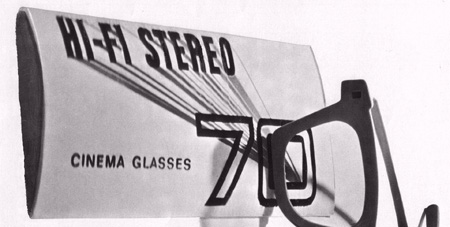 The CineStar IMAX cinema is described in the
Berlin Cinema Compendium The CineStar IMAX cinema is described in the
Berlin Cinema CompendiumThe association ”Kinomuseum Berlin e.V.” (Board of managers: Jean-Pierre Gutzeit, Uwe Borrmann, Joachim Kelsch) get involved in preserving, arching and maintaining the historic and ongoing cinema culture (according to the original form) The Holographic Studio of the Scientific Research Cinema & Photo Institute (NIKFI) in Russia (Moscow) The company Chace Audio in Burbank, California provides the best cinema sound and is also responsible for the restoration of old soundtracks The life of Willi Burth: Museum in the Cinema-Center “DIE BURG“ Ravensburg The Film- and Televisionmuseum Hamburg List of 3D-Films |
|
|
Go: back
- top - back issues
- news index Updated 22-01-25 |
|
